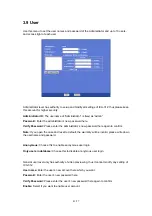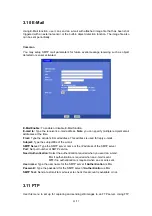
IP Address:
This address is a unique numbers that identifies a computer or device on the
WAN or LAN. These numbers are usually shown in groups separated by periods, for example:
192.168.0.200
Subnet Mask
: Subnets allow network traffic between hosts to be separated based on the
network's configuration. In IP networking, traffic takes the form of packets. IP subnets advance
network security and performance to some level by organizing hosts into logical groups.
Subnet masks contain four bytes and usually appear in the same "dotted decimal" data. For
example, a very common subnet mask in its binary demonstration 11111111 11111111 11111111
00000000 will usually be shown in the corresponding, more readable form as 255.255.255.0.
Gateway:
A gateway is a piece of software or hardware that passes information between
networks. You'll see this term most often when you either log in to an Internet site or when
you're transient email between different servers.
Primary DNS
: When you send email or position a browser to an Internet domain such as
xxxxx.com, the domain name system translates the names into IP addresses. The term refers
to two things: the conventions for naming hosts and the way the names are control across the
Internet.
Secondary DNS
: The same function as DNS1. It is option not necessary
Note:
need to reboot the device to take this setting effect.
HTTP Port:
The device supports two HTTP ports. The first one is default port 80 and this port
is fixed. This port is very useful for Intranet usage. The second HTTP port is changeable.
Users could assign the second port number of http protocol, and the WAN users should follow
the port number to login. If the http port is not assigned as 80, users have to add the port
number in back of IP address. For example:
http://192.168.0.20:80
.
If multiple devices are installed on the LAN and also required to be accessed from the WAN,
then the
HTTP Port
can be assigned as the virtual server port mapping to support multiple
devices.
Video Port:
Specify the transmission port number of video stream. The default value is 5000.
User can specify a number between 1024 and 65535.
Audio Port:
The Audio port value is equal to Video port plus one and it cannot be modified by
user manually. (The function is useless in this model)
When the configuration is finish, please click “OK” to save and enable the setting.
3.5.2 DDNS server
DDNS: Stands for Dynamic Domain Name Server
The device supports DDNS. If your device is connected to xDSL directly, you might need this
feature. However, if your device is behind a NAT router, you will not need to enable this feature.
Because DDNS allows the device to use an easier way to remember naming format rather
than an IP address. The name of the domain is like the name of a person, and the IP address
is like his phone number. On the Internet we have IP numbers for each host (computer, server,
router, and so on), and we replace these IP numbers to easy remember names, which are
organized into the domain name. As to xDSL environment, most of the users will use dynamic
IP addresses. If users want to set up a web or a FTP server, then the Dynamic Domain Name
Server is necessary. For more DDNS configuration, please consult your dealer.
Your Internet Service Provider (ISP) provides you at least one IP address which you use to
29/57
















































